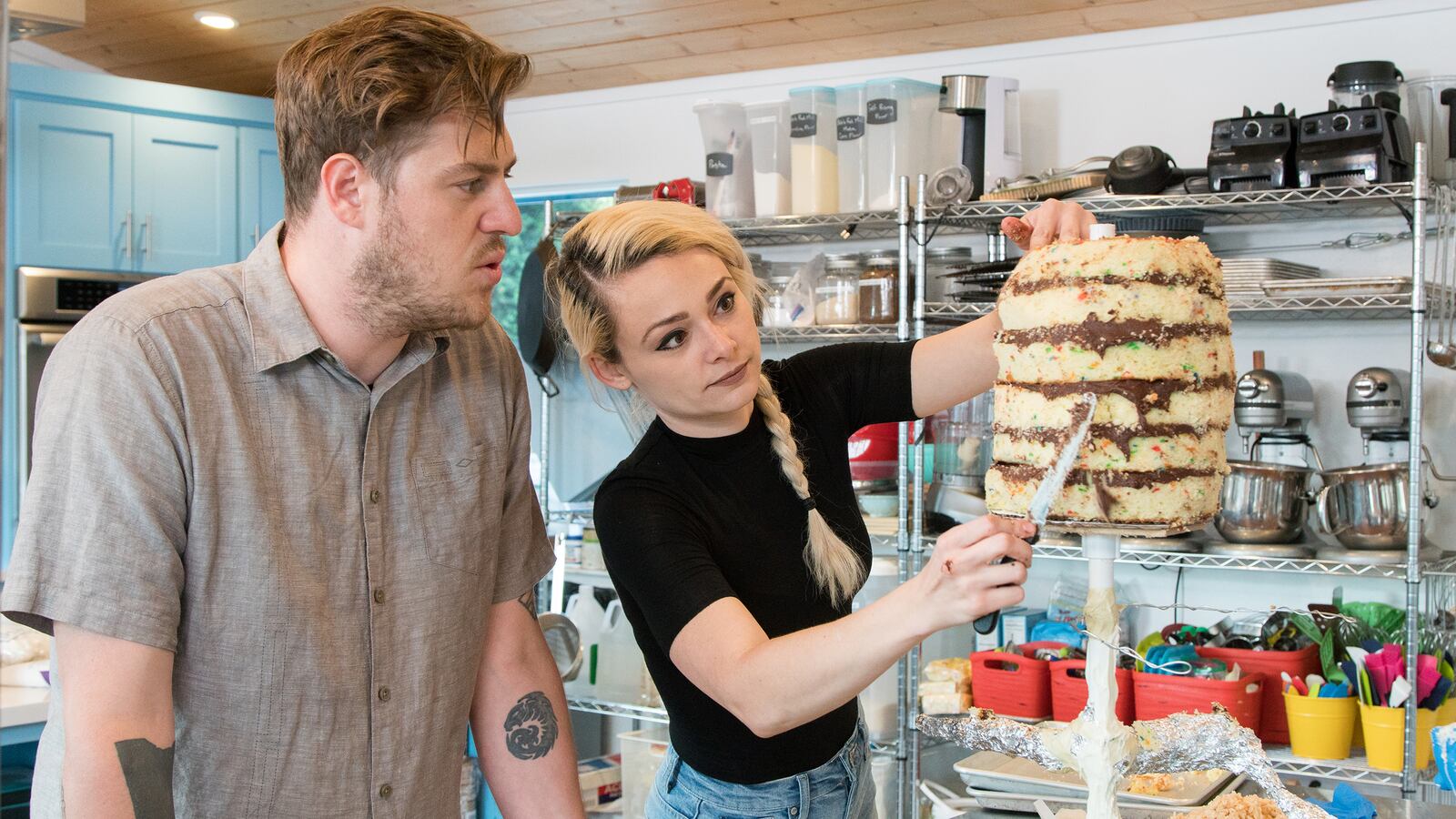Natalie, how did you go from studying studio art at Ohio State to making cakes in Austin?
Natalie Sideserf: “A friend of mine who used to watch a lot of cake competition shows said, ‘you’re good at sculpting; you should do this.’ It turns out cake is a material I like working with. Working with cake is just like sculpting with clay, or wire, or whatever, which I had done a lot of as an artist. Soon after that, there was an opportunity in Austin for me to go work in a bakery. I started working and they let me make cakes the way I wanted to. In 2013, a Willie Nelson cake I made hit #1 on Reddit—my brother posted a picture, and it got millions of views—and I realized I was on to something.”
Dave, when did you decide to bake cakes full-time?
Dave Sideserf: “Before this, I was a director at a tech company that worked with a lot of big businesses. When we moved to Austin and decided to start a business of our own, I incorporated those things into our business. We spent five or six years building a brand, becoming known for making crazy, elaborate stuff, and now we have a Food Network show! I’ve also always had a strong attraction for food: I worked as a line cook growing up and through college, and to this day, I cook as much and as often as I can.”
How did you two meet?
N: “We’re both from Cleveland. That’s where we met. We had mutual friends as teenagers but had never met each other in person. It’s embarrassing to say now, but after I graduated from college, we actually met on MySpace. We immediately connected and hung out non-stop after we met. It happened pretty fast, and we really haven’t been apart ever since.”
Is there a secret to making a cake look like a real person?
N: “For me, it’s conceptual: I like to have a story behind it. I also have to research the person. I’m gathering photos from tons of angles, watching videos if I can find them—for the Willie Nelson cake, videos of him singing and moving around were really helpful in getting the three-dimensional shape right. I’m really using my art background, finding edible materials that represent other things. Sometimes we use food coloring like watercolor, sometimes like oil paint. I try to replicate all these painting and sculpture techniques.”
D: “We went to an exhibit recently of work by Ron Mueck, a sculptor who’s known for photorealism. When you get really close to his realistic sculptures, there’s a layering of colors. Natalie uses that same technique, and it makes a big difference.”

N: “When it comes to skin tones, people think it’s a pretty basic tan or brown color. But I’m layering up a ton of colors—warm browns, cool browns, purples, blues. That layering really makes the cakes lifelike. It’s the same as with painting.”
How is cake-decorating different than painting or sculpture?
N: “I would say the materials. You’re using chocolate and sugar, and these things are really temperature-sensitive. Things are gonna settle; things are gonna shift. It’s about learning to use the materials and control the temperature so they don’t get ruined.”
D: “There’s also a time sensitivity too. You don’t want the cake to dry out or go bad. We have to cover the cake in ganache or fondant very quickly or it’ll dry out. We can’t spend two weeks working on a cake or it’ll go bad.”
N: “With clay, you can spend months or years on something, and with cake, I only have a few days.”
How did you learn the baking skills you needed to start your business?
N: “I didn’t start baking until I got really involved with the cake-decorating thing. But it’s very important: You have to make sure that the structure of the cake will hold up.”
D: “I really geek out on a lot of the science of baking, and one of my first tasks when I became part of the business was figuring out how to create a cake dense enough for sculpting and carving. We took out some egg white and use more egg yolk to make a rich cake. But you have to use more leavening to make sure the cake comes out light and airy. It took a lot of trial and error to come up with the recipe. I also have a lot of fun coming up with flavors and flavor combinations that fit in with the design and the theme of the event. We did a cake for an Alamo Drafthouse event, and they wanted Jägermeister in the cake. So we cooked down Jägermeister, looked at the flavor elements of it, and created a non-alcoholic syrup using some of the same flavors. It wound up being a Jägermeister-chocolate cake with an orange bitters buttercream. There were lots of movie people there, and they loved it!”
What’s your favorite part of your Food Network show Texas Cake House?
N: “The show shows you the whole process, how we go from the design to the finished product. I love that people can see how much goes into making something for an event. With our cakes, it’s not just ‘hey, can you use our logo?’ We get to go crazy and do whatever we want.”
D: “It’s also really Austin-centric. Austin itself is almost featured as a character. There’s something going on every day here, and they always want unique, outside-the-box ideas. The old mantra of ‘Keep Austin Weird’ is definitely still alive.
Which cake from Texas Cake House are you most proud of?
N: “Honestly, I love ‘em all. But one that I really thought was interesting was one we made for the Texas Museum of Science and Technology. The cake was supposed to represent a constellation, and we made a cake of Ursa Major [AKA the Great Bear]. It’s this giant bear who looks like he’s made out of stars, but then we painted the constellation itself on him in this special glow-in-the-dark food coloring you can only see under blacklight. That was really cool.”

Do you have any cake-decorating tips for home bakers?
N: “I think that there are some materials out there that people don’t know about. Modeling chocolate completely changed my life. You can order it online, but you can also make your own: You just melt down chocolate and add corn syrup, but you have to use a very specific ratio. Try working with modeling chocolate to make little sculptures—cupcake toppers and the like. It’s kind of like Play-Doh; it’s easy to mold, and to blend separate pieces together. From there, you can start testing out different materials like fondant to see what works for you. It’s difficult, but you’ll get better.”
Are you guys big cooks when you’re not making cake?
D: “We cook everything. I get real bored real fast, so I don’t like to make the same thing over and over. We’ve been through Mario Batali’s Molto Italiano twice; we have a subscription to Cook’s Illustrated.”
N: “The more complicated the recipe, the more he likes it!”
Is it hard being in business with your spouse?
N: “Dave worked from home before, so we have always been together. But now it’s like another level of being together. It’s a lot of compromise and understanding each other’s personalities. I feel like we’re closer than ever now that we’re working together.”
D: “Being married, we each understand how the other thinks. That’s how a lot of our designs will come together. She’ll have an initial idea and we’ll just keep growing that, and then we end up with something like a severed head cake for our own wedding! We definitely ‘get’ each other, and that’s the most important part of working together.”
You’re being sent to a desert island and can only have one flavor of cake. What do you pick?
N: “I’m always a huge fan of chocolate, so chocolate cake, maybe with strawberry for the frosting.”
D: “Vanilla cake with chocolate ganache. But I really like Mexican vanilla more than Madagascar vanilla for the smokiness and flavor it has. So Mexican vanilla cake, with chocolate ganache.”
You can see Natalie and Dave Sideserf’s latest creations on Texas Cake House, which airs Monday nights on Food Network. The final two episodes of Season 2 premiere tonight.
Interview has been condensed and edited.






